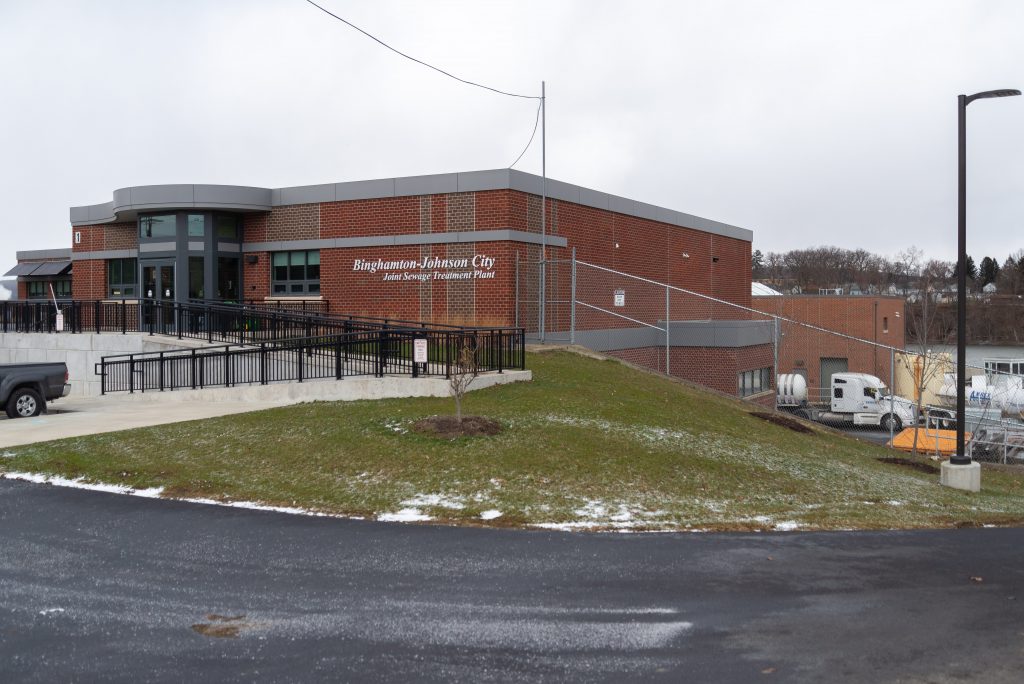The Binghamton-Johnson City Joint Sewage Treatment Plant experienced wastewater flooding that released a significant amount of discharge into the Susquehanna River last month.
The incident occurred on Feb. 18, when a pipe burst inside the facility, flooding parts of the building with untreated water. According to WSKG, employees worked throughout the weekend to pump water out of the building, but a large amount of leftover solids remained the next week. The sewage plant declared an emergency during a board meeting on Feb. 23, passing a measure to allow cleanup and repair-related purchases and contracts.
The plant — jointly owned by the city of Binghamton and the village of Johnson City — treats 60 million gallons of water per day, according to the city of Binghamton’s website, allowing for sewage and water from the surrounding areas to be returned back into the Susquehanna River. The spill left the plant’s sewage treatment operations inoperable and caused untreated water to flow into the Susquehanna River.
According to the plant’s meeting minutes, the discharge may affect public and employee health, as well as the well-being of the environment. The New York State Department of Environmental Conservation (NYSDEC) had inspected the site on Feb. 25 and said that the incident was not expected to impact public drinking supplies, according to WSKG.
Yuxin Wang, a research assistant professor and lecturer of environmental studies at Binghamton University, said she anticipated potentially negative effects on the environment and ecosystem of the Susquehanna River.
“Specifically, it increases the nutrient levels in the water and potentially causes harmful algae blooms,” Wang wrote in an email. “The organic contaminants in the partially treated sewage may still have the potential to affect downstream drinking water treatment systems and increase their treatment cost.”
Wang said the discharge had led to an increased quantity of suspended solids and oxygen used in the oxidation of “carbonaceous organic matter” in the river, but said the NYSDEC report indicated the spill was not likely to impact river quality downstream.
Robert Holahan, an associate professor of environmental studies, said the pollution may not have long-term effects on the river.
“Once the river washes it all away, it will go away,” Holahan wrote in an email. “The problem is with combined sewer overflows, which allow untreated wastewater to go directly into the Susquehanna and Chenango Rivers during heavy rain events. Since those overflows happen at the same location multiple times per year, the long-term impacts are probably higher than a single wastewater flood.”
The Waterman Conservation Education Center, which is located in Apalachin, New York, specializes in environmental education and the preservation of nature. The Center owns Hiawatha Island, the biggest island in the Susquehanna River, home to ecosystems that could potentially be impacted by the pollution. Christopher Audette, the executive director of the Waterman Conservation Education Center, discussed how pollution from the incident may impact the environment.
“The primary environmental concern is the introduction of nutrients (similar to fertilizer runoff) that increase water temperature, decrease the availability of oxygen and contribute to the growth of undesirable algae that further contribute to the first two problems,” Audette wrote in an email. “Another concern is sedimentation from the sewage solids that degrade habitat, especially fish and amphibian breeding habitat.”
Audette said the plant’s efforts to reverse some of the damage has lessened the severity of the discharge’s effects, but potential issues remain.
“Considering that it seems primary and secondary treatment have already been accomplished, these concerns are minimized, but not eliminated,” Audette wrote. “I don’t anticipate many acute, short-term impacts on wildlife. There is, of course, the possibility that the influx of nutrients, however mitigated, will contribute to the long-term eutrophication [(the process of nutrient enrichment)] of our watershed, which in turn cascades to impacts on the Chesapeake Bay.”
Jacey Ruisi, an undeclared freshman, said she feels worried about the situation.
“Honestly it is super concerning, and I think that the [plant] should notify everyone, especially the people it directly impacts,” Ruisi said. “Also I hope they took measures to make the water cleaner.”
The Waterman Conservation Education Center declared the lightly polluted area safe for all outdoor activities but implored everyone to continue basic good hygiene practices around the Susquehanna River.
“Never drink untreated water from any waterway and always wash your hands before eating if you’ve come into contact with the water, sediment or any organisms (such as is the case with fishing),” Audette wrote.
Rachel Barrale, a sophomore majoring in biology, related the wastewater flood to a broader outlook on environmental awareness.
“I believe this [incident] gives us a vital opportunity to observe the detrimental impact on the environment displayed [near] our own campus,” Barrale said. “As well as, now, more than ever, action must be taken to look at the global and local actions we take and what those effects will be.”
The Binghamton-Johnson City Joint Sewage Treatment Plant declined to comment.



